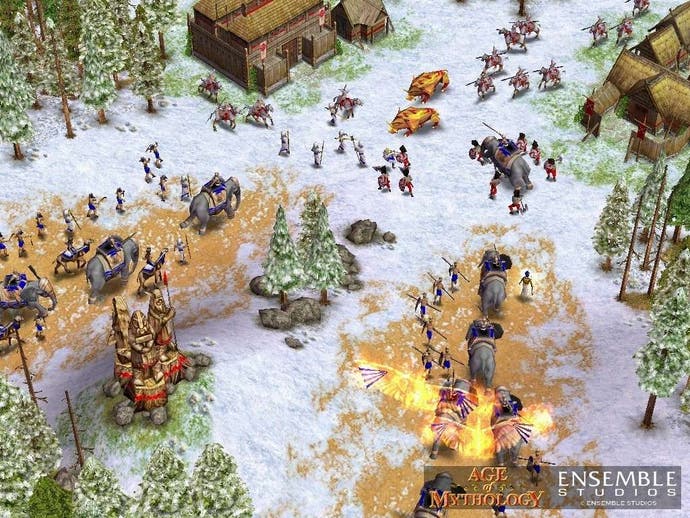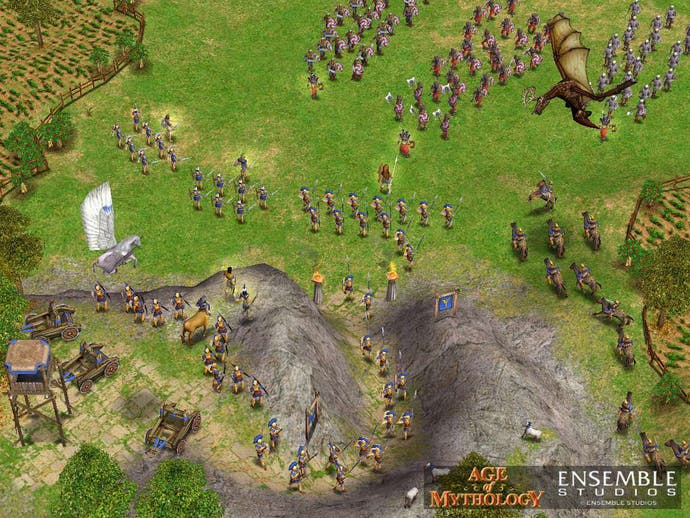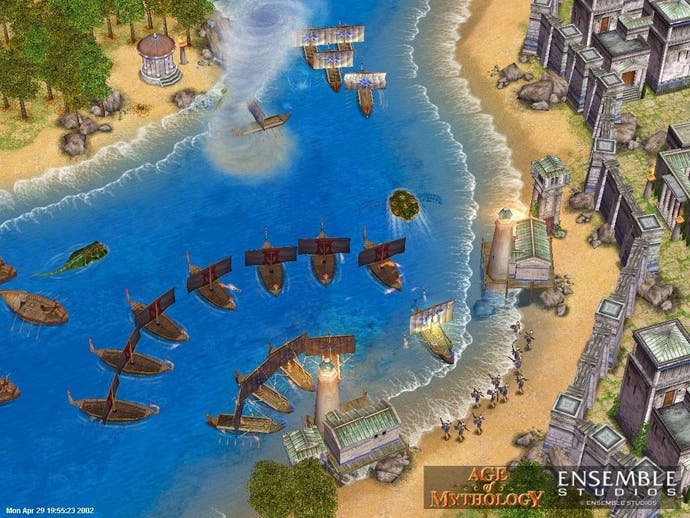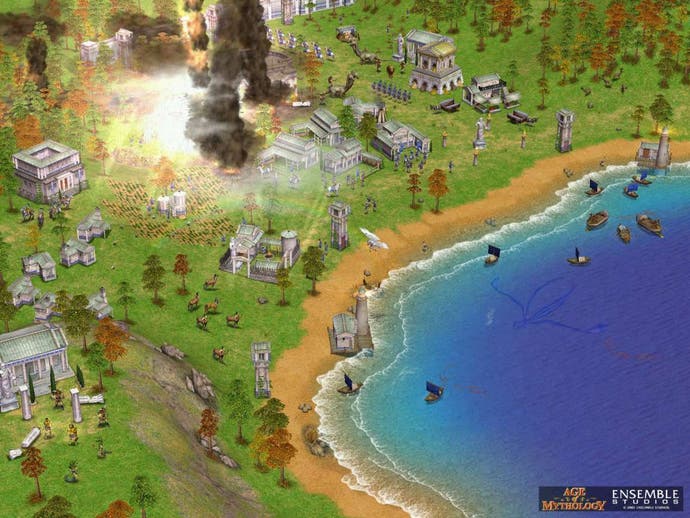Age of Mythology
Review - Rob's mythical review is finally complete
PC real-time strategy fans are somewhat spoiled this year, with two of the three biggest franchises in the genre getting major overhauls. Blizzard's WarCraft III saw the series take a radical new direction earlier this year, earning rave reviews and an overwhelmingly positive reception from its fans, and now it's the turn of Microsoft's franchise, Age of Empires, to show off its new colours with its third incarnation, Age of Mythology.

Déjà vu
On the surface at least, Age of Mythology seems to have rather a lot in common with WarCraft III in terms of what's been added. Like WarCraft, Age of Mythology takes the basic gameplay of the earlier games in the series, adds significantly enhanced story aspects, RPG-like hero characters and a selection of more complex, plot-driven missions, then wraps the whole lot up in a 3D engine. As a result, the two games are destined to be compared at every turn - which is somewhat unfair, because behind these superficial similarities lie two very different types of game.
Where WarCraft III moved heavily into the realms of RPG gameplay, with heroes who level up and a focus on micro-management of small numbers of units, Age of Mythology has gone in almost entirely the opposite direction, going instead for gameplay focused around huge numbers of units and heroes who, outside of their duties in carrying the plot forward, are really no more than powerful special units. At its most basic level, Age of Mythology strays far less from the path of the traditional RTS than WarCraft III did - while still managing to innovate within the boundaries of the franchise itself.

Good God
The key difference between Age of Mythology and earlier titles in the franchise - and it's this that is the reason for the change of title as well - is the addition of mythological units, powers and gods. Advancing through the ages of the game now requires that you choose a new god to worship with each advancement - giving you a highly customisable selection of godly powers, mythological creatures and civilisation enhancements to play with, depending on which god you choose at each advancement.
Obviously, with this, any semblance of historical accuracy carried by the original games goes out the window - the single-player campaign starts with Atlantis being attacked by Krakens, to give you some idea of the scale of mythological silliness we're talking about here. To the credit of the developers, however, they've done a vast amount of homework in researching the ancient mythologies they cover in the game - namely Greek, Egyptian and Norse - which makes the game feel just as cohesive and consistent as its predecessors.

Divine Intervention
The big question, of course, is whether the addition of powerful hero units and mythological units - never mind godly powers - unbalances the gameplay. Thankfully, Ensemble Studios has not lost its touch, and the more fantastical units fit in perfectly alongside traditional infantry, archers and siege weapons, which are the mainstay of Age of Empires gameplay. Rather than making mythological units more powerful than anything else on the battlefield, the developer has chosen to simply add them into the complex rock, paper, scissors game which underlies any good real-time strategy title.
God powers are equally well balanced, although they can sometimes feel rather pathetically weak for commands which are meant to represent the intervention of deities in the affairs of men. Those of us brought up in faiths which wax lyrical about rains of fire on Sodom and Gomorrah may be somewhat disappointed to note that Zeus, father of the gods, won't stretch himself beyond a quick thunderbolt that kills a single unit, while the rather promising Plague of Serpents ability summons a shower of the weakest snakes you've ever encountered. Each ability can only be used once, although there are so many of them that in general you'll be able to find one that improves your personal playing style.

Love Triangle
Although the range of customisations available to each race in the game is huge, thanks to the various different gods demanding worship, long-time fans of the series may be somewhat disappointed by the miniscule number of initial races to choose from. Ensemble has taken a leaf from Blizzard's book on this particular topic, providing three races with very different types of gameplay, and then aiming to satisfy traditional AoE fans with the ability to customise those races further. The approach works well; compared to the almost identical races offered to the player in earlier games in the series, the three central races in Age of Mythology are entertainingly different and players will probably play with each of them for a while before settling on their favourite.
The single-player campaign provides a good grounding in how each race works, providing a single narrative thread that runs through campaigns as each of the races. The storyline itself is relatively entertaining, borrowing aspects from a variety of ancient myths and using WarCraft-style in-engine cut scenes to advance the plot. Missions in single player are varied and generally a lot of fun, with a good gradient on the difficulty curve which makes the game challenging but certainly not frustratingly difficult, even for a relatively unskilled RTS player.

The Third Place
Moving into three dimensions hasn't made much of an impact on the way Age of Mythology plays, although the developer has tweaked a few things to take advantage of the new graphics engine. Building placement no longer conforms to a strict grid, for example, with the player able to drop down buildings anywhere that there's room for them - particularly useful when constructing walls and other defences. In general, the whole game seems smoother and slicker, and not even with dozens of units on screen does the frame rate take a hit. The view can also be zoomed out significantly further than it could in WarCraft III, which is a good thing in our view since one of the most annoying aspects of WarCraft III over extended play was the downright claustrophobic camera.
Audio-wise, the music in Age of Mythology is quite good - particularly the rousing title theme of the game - although it can't quite compare to the superb orchestral score which accompanied WarCraft III. There's really not much to write home about here in terms of sound effects, either. As with its predecessors, AoM takes the time to make sure that each race has accurately recorded sounds, so peasants and soldiers acknowledge orders in their native languages - a nice touch, but that's about the height of it as far as sounds go.
Conclusion
Age of Mythology is certainly going to suffer badly by comparison to WarCraft III. The latter game is very innovative and has production values higher than just about any game ever released on the PC, while Age of Mythology is simply a worthy successor to an excellent series. It's in that context that it's most fair to judge AoM - as a game which improves upon its predecessors and will provide hours and hours of entertainment for fans of the Age of Empires titles or of traditional RTS gameplay. WarCraft III is simply in a league of its own, and there's no real reason not to own both games if you're an RTS fan.

